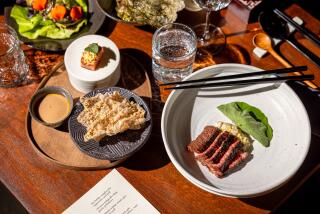Gascony, France: Flavorful experiences are on the menu at Camont’s cooking school
Reporting from Ste. Colombe-en-Bruilhois, France — “I was looking for a good place to park my boat” is how Kate Hill, an American woman who grew up in Southern California, explains what brought her to this particular spot in Gascony, a rural region in southwestern France.
Hill had been cruising the canals of Europe for several years as skipper and chef of her own passenger-carrying charter canal barge, the Julia Hoyt, when it developed engine trouble on the Garonne Canal and needed repairs. From where Hill tied up, it happened that she could just see, over some trees, the top of a tower, the pigeonnier, or dovecote, of Camont, an abandoned 18th century brick and stone farmhouse.
She investigated, saw possibilities and bought the place. The Julia Hoyt had been known for its gourmet meals, so Hill decided to restore Camont and turn it into a B&B and cooking school.
Although French cooking schools usually focus on classic haute cuisine, at her school, the Kitchen at Camont, Hill decided to emphasize Gascony, which is as agriculturally diverse as it is lushly beautiful. “Gascon cuisine is country cooking, food with integrity,” she says. “It’s not so much about technique as putting good food on the table in every season.”
Her cooking classes, always held in the old farmhouse kitchen, reflect this unpretentious attitude. I had never been to a French cooking school and was half expecting an imperious, no-nonsense chef in starched whites and a tall hat. Still an informal Californian despite many years in France — Hill wore a house dress, sandals and faded blue apron — she chatted rather than lectured. She talked enthusiastically about where she got her meat, poultry and vegetables, the best time to buy them at which markets, and what the farmers who produced them were like.
The handful of students (all women except for me) were participants, not just listeners, and while Hill talked we all got to do something useful. My job — once I mastered tying on a long apron — was to slice pâte. Others pitted prunes or seasoned duck. The essential ingredients of the local cuisine, she explained, are duck, prepared many ways, prunes and Armagnac, a brandy made locally by small artisan producers. “Armagnac adds rustic finesse to regional dishes,” Hill says.
Another thing that gives Gascon food its distinctive taste is quatre épices, or “four spices,” a mixture of nutmeg, ginger, cinnamon, cloves and an uncounted fifth ingredient, black pepper. “It should really be called ‘five spices,’ ” acknowledges Hill, “but in Gascony it’s just taken for granted that any spice mix will include black pepper; these spices are to dark meats, like duck, what thyme and bay leaf are to white meats like chicken.”
Kitchen at Camont students learn about Gascon cuisine from the ground up. “We go the village markets and out into the countryside to meet local cooks and butchers and also farmers, the people who turn dirt into food,” she says. “Chefs usually know a lot about cooking but often don’t know anything about food, and my school is a culinary retreat where students, chefs and artisan food producers meet and work together.”
Among the local signature dishes Hill teaches her students are Gascon salad, which includes duck, pâte de foie gras and prunes; duck breast stuffed with prunes or foie gras; and, of course, duck seasoned with quatre épices. Also, such Gascon favorites as wild mushroom pie and roast pork stuffed with prunes and shallots.
It’s been 20 years since Hill’s barge fortuitously broke down, and she now has deep roots in Gascony. “I’ve been happy ever since I came here,” she says of the area of France famous not only for its robust food but also its feisty literary characters such as Cyrano de Bergerac and D’Artagnan of “The Three Musketeers.”
The cooking school opened in 1991 after the farmhouse was extensively renovated, including a new roof. “There was a tree growing where my kitchen is now,” she remembers. The large kitchen, which occupies most of the ground floor, also serves as the school classroom.
Hill offers weekend workshops, day classes and long-term study. Besides hands-on cooking lessons, the programs include time spent weeding gardens, planting fruit trees, feeding chickens and other typical farm chores.
She rents two double rooms in the house; larger groups usually stay at an inn within walking distance of Camont. Long-term students, such as those learning to be butchers or sausage makers, stay with nearby farm families. Hill herself still lives on the Julia Howe, which is anchored at the foot of a canal-side vegetable garden, a year-round source of soup ingredients.
Most of her students are Americans, and since Sept. 11 she notes that there has been a noticeable change in U.S. visitors to France. “There aren’t as many of them, but now they’re more serious and want to learn something about local culture, not just be cultural voyeurs.”
“Teaching allows me to get deeper into something that I love,” Hill says. Her programs are meant to give students the same sort of experiences and learning opportunities she had when she first started cruising the Garonne Canal.
The canal, which parallels the Garonne River, runs through countryside dotted with farms and many small towns like Ste.Colombe-en-Brulhois. “The canal is really like a long village, and the weekly farmers markets held along it are phenomenal,” Hill says. “A sense of the palate is what this place is all about.”
More to Read
Sign up for The Wild
We’ll help you find the best places to hike, bike and run, as well as the perfect silent spots for meditation and yoga.
You may occasionally receive promotional content from the Los Angeles Times.






